BEST Traditional Mincemeat
This post may contain affiliate links. See my disclosure policy.
If you’ve never cared for the store-bought stuff or even most homemade versions, you’re not alone. But just wait until you’ve tried this genuinely authentic, old-fashioned homemade mincemeat – it’s a total game-changer! Whether you’ve never liked mincemeat or you’ve always loved it, prepare to either be converted or to fall even more deeply in love! With this authentic mincemeat recipe in hand you’ll be able to make the most scrumptious homemade Mince Pies!

Few people today know the taste of true, authentic mincemeat, a dish dating back to the 11th century. And that explains why very few people I know actually truly enjoy mincemeat versus simply eating it out of tradition (or being forced to so as not to offend Grandma!). Sadly the authentic way of making mincemeat has been largely lost in the last century.
Whatever Happened to Traditional Mincemeat?
And I say lost, not because it’s been erased completely, rather because mincemeat has changed so much, some of its most important elements having been left out, that it just barely resembles its original ancestor. Of the many traditional British dishes that have undergone some form of alteration over the years, mincemeat has probably changed the most. That is largely due to the common omission of mincemeat’s two key ingredients: Meat (traditionally beef or lamb) and suet.
Things like wartime rations on meat, British culinary tastes moving away from sweet-savory combinations, and shifting trends away from the traditional use of suet (read my article on why you should use suet and lard – in short, medical research confirms our ancestors were right after all!) contributed to the gradual moving away from the inclusion of meat and suet in mincemeat. The result of these changes is manifest in the tiny mince pies of today that are almost sickly sweet without the savory meat and suet to round out the flavors and also fairly flat and one-dimensional in flavor profile without the complexity of the savory ingredients. This beloved dish of both the common folk and royalty (savored by generations of kings who enjoyed mince pies during their coronations and at their stately tables) sadly has been reduced to something that is a mere vestige, a residue, of what it once was – the spirits of centuries ago hover over what is passed off today as mincemeat while clenching their fists and wailing in agony.
Okay, that’s a little dramatic.
Essential Ingredients
Many generations ago people would experience mincemeat as a robust and sweet-savory meat-based mixture that conjured up what seemed like a thousand flavor sensations. Pair that with the incomparable texture that suet contributes to pie crust as it’s baked with the mincemeat and it’s no wonder that mincemeat pie was a heralded favorite for many centuries in the United Kingdom and then made its way to become a tradition in Canada, Australia, New Zealand, Ireland, Northern Europe, South Africa, and the New England region of the U.S..
Mince pies are still considered an essential accompaniment to holiday dinners today. But to be truly “traditional”, mincemeat requires meat and suet.

A note about SUGAR: Centuries ago mincemeat was far less sweet than it is today. Though it was made with fruits to add sweetness and to help preserve it (the fructose content), no sugar was added. Feel free to cut back on the brown sugar if you prefer.
A note about MEAT: If you’re put off at the thought of adding meat to mincemeat like our ancestors did for centuries, think of it this way: Imagine a Moroccan tagine – a dish of beef or lamb that is slow cooked with dried fruit, nuts and a myriad of aromatic spices. It’s downright amazing. Mincemeat, which not surprisingly originates from the Crusaders bringing the spices and method back with them from the Middle East, is a very similar concept: Beef that is simmered with dried fruits, nuts and a wonderful host of spices. That doesn’t sound so bad, does it? The mincemeat is stored for a while (under a layer of fat, a centuries-old method of preservation) so the flavors can deepen, and then it’s baked in a flaky pie. Heaven.
Why Make Your Own Candied Citrus Peel?
Another aspect that has always been off-putting to me about mincemeat is the overpowering flavor of the commercial candied citrus peel that’s called for in most recipes. It has a strong chemical-astringent flavor that many people dislike. For that reason I use and highly recommend making your own homemade candied orange peel for this mincemeat. Trust me, the flavor is incomparable and puts the store-bought stuff to miserable shame. And good candied citrus peel gives mincemeat an incredible flavor boost. That said, if you don’t mind store-bought candied citrus peel and want to save yourself the effort, feel free to use it.
Check out our post on how to make Candied Orange Peel.

Why Use Suet?
While you “can” substitute butter (and even coconut oil, though that will greatly alter the flavor), I highly recommend suet for both flavor and texture, especially if you’re making mince pies. If you’ve ever made pie crust with suet you’ll understand – the end result is flaky and flavorful perfection unlike anything else. When you’re baking your mince pies the suet will bake into the pie crust enhancing texture and flavor.
I usually make my own suet when I have access to some kidney fat from locally-raised, grass-fed cows. Check out my tutorial on How to Make Beef Tallow. It’s super easy to make yourself. For a store-bought option I recommend Atora Shredded Beef Suet from England and a household name since 1893, but it’s usually extremely expensive to buy outside the UK.
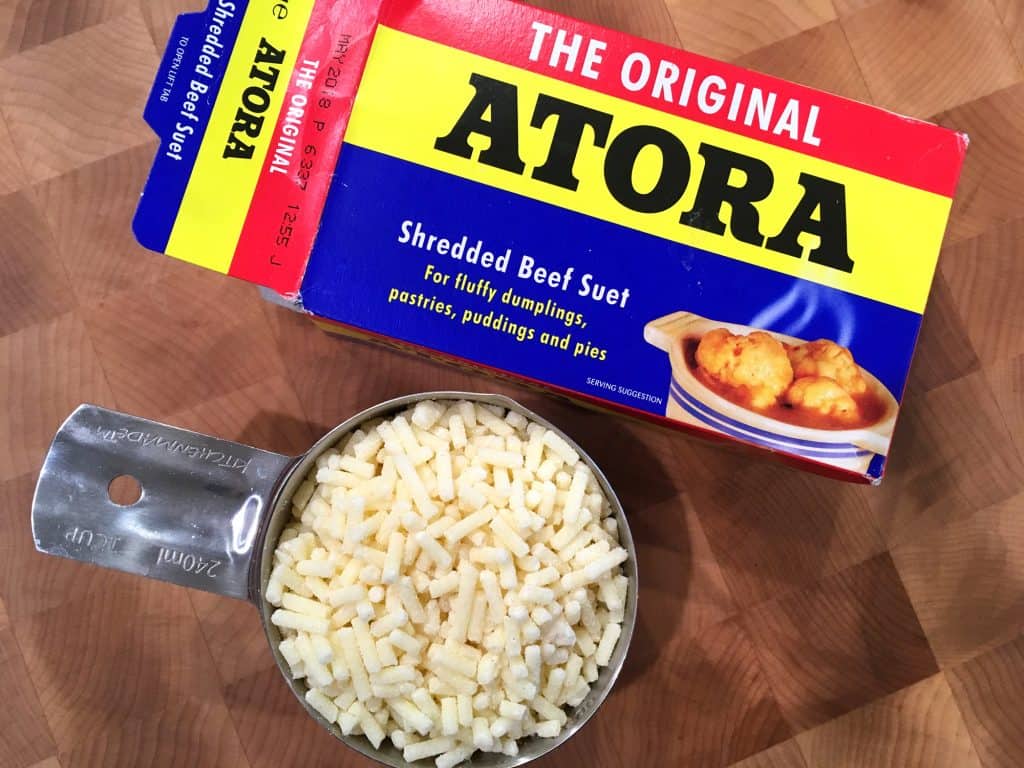
How to Can Mincemeat
A note about PRESERVING: Traditionally mincemeat would be made the year before it’s eaten to give the flavors time do develop and deepen. While time does improve it, it is delicious eaten within just a few days. However, if you want to store it there are several options:
Refrigerator: If you omit the meat it will last for up to a year in clean sterilized jars (some keep it several years in the back of the fridge). The layer of fat on top seals off the mincemeat from any air which results in food deterioration. This is a method of preserving that’s been used for many centuries. If you include the meat it will safely last in your fridge for up to 2 weeks.
Freezer: Either with or without meat, mincemeat can be frozen in airtight containers or in ziplock bags for up to 6 months.
Canning for long-term storage: If you want the traditional meat version to keep longer you can process the quart-sized mason jars (leaving 1 inch headspace) in a pressure canner (not a water bath). Spoon the hot mincemeat into sterilized quart mason jars leaving 1 inch headspace. Use a clean moist rag to wipe off any oil from the jars. Seal and process in a pressure canner according to the time and pressure outlined in the chart below and the mincemeat will keep for up to a year:
| Recommended process time for a dial-gauge pressure canner. | ||||||
| Canner Pressure (PSI) at Altitudes of | ||||||
| Style of Pack | Jar Size | Process Time | 0 – 2,000 ft | 2,001 – 4,000 ft | 4,001 – 6,000 ft | 6,000 – 8,000 ft |
| Hot | Quarts | 90 min | 11 lb | 12 lb | 13 lb | 14 lb |
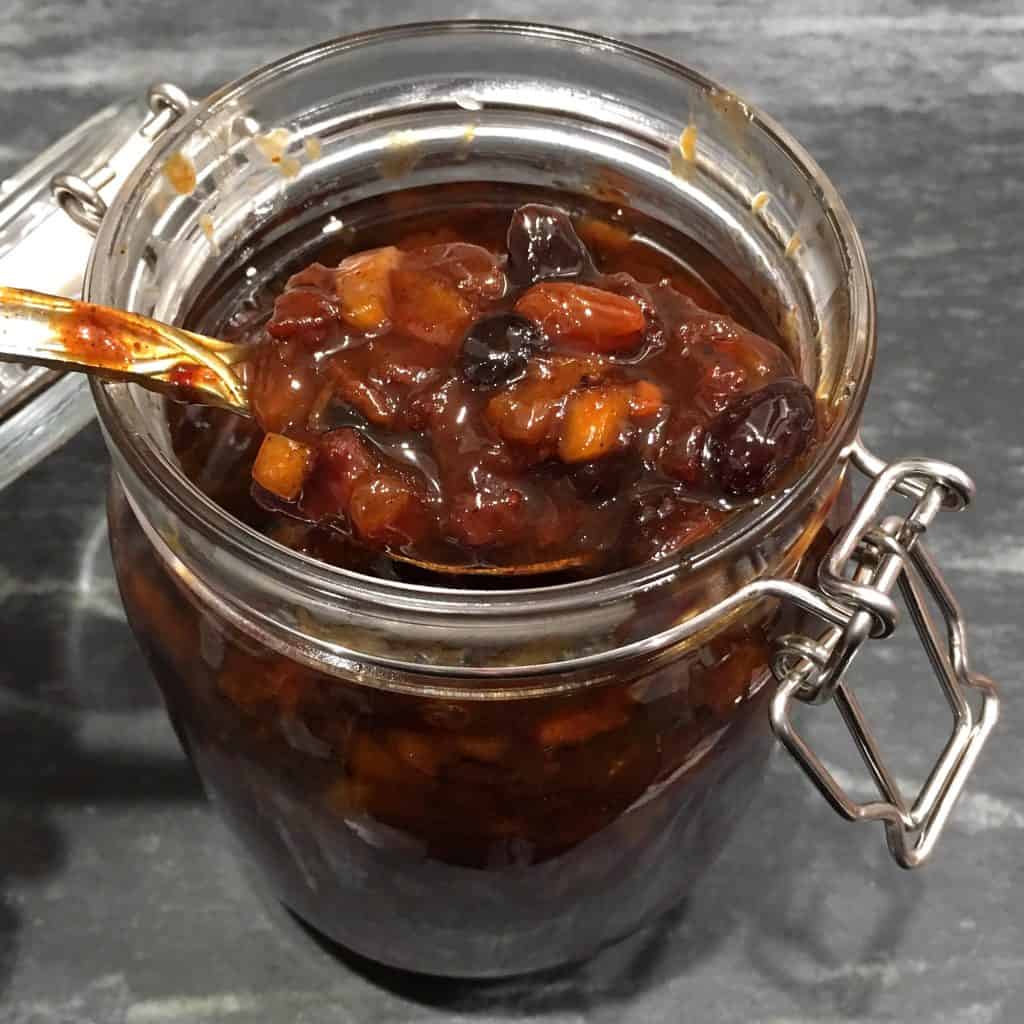
Mincemeat Recipe
Let’s get started!
Combine all of the ingredients, except for the brandy and/or rum in a medium-sized pot.
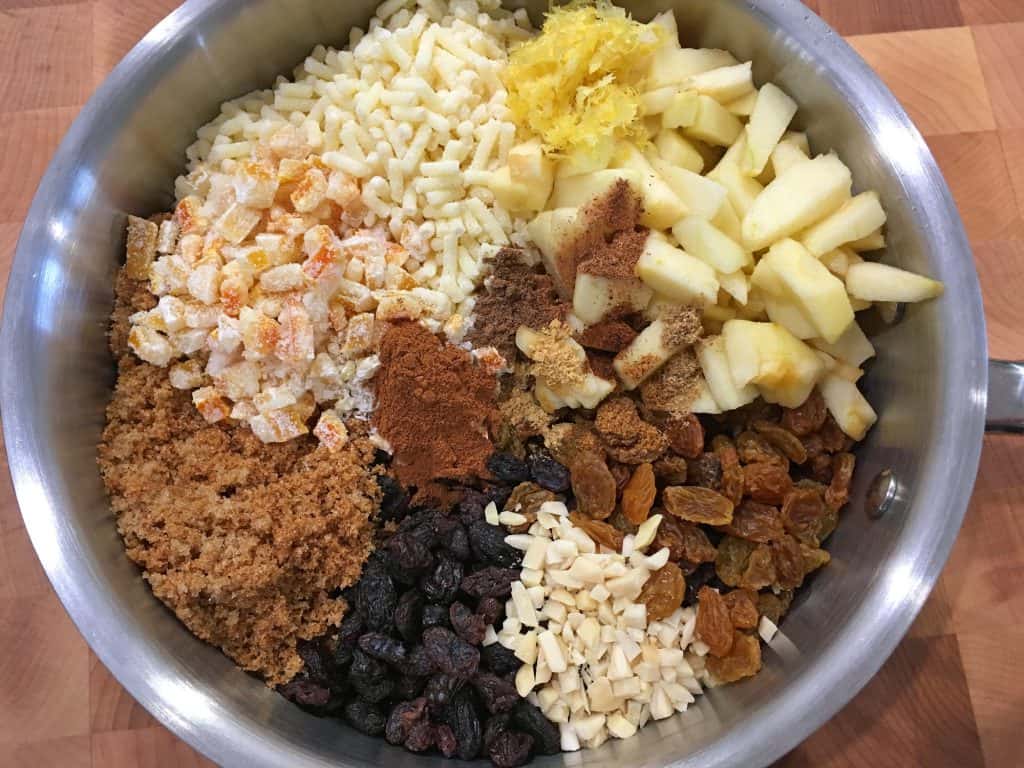
If you’re adding meat, which I highly recommend, you’ll add that at the same time.
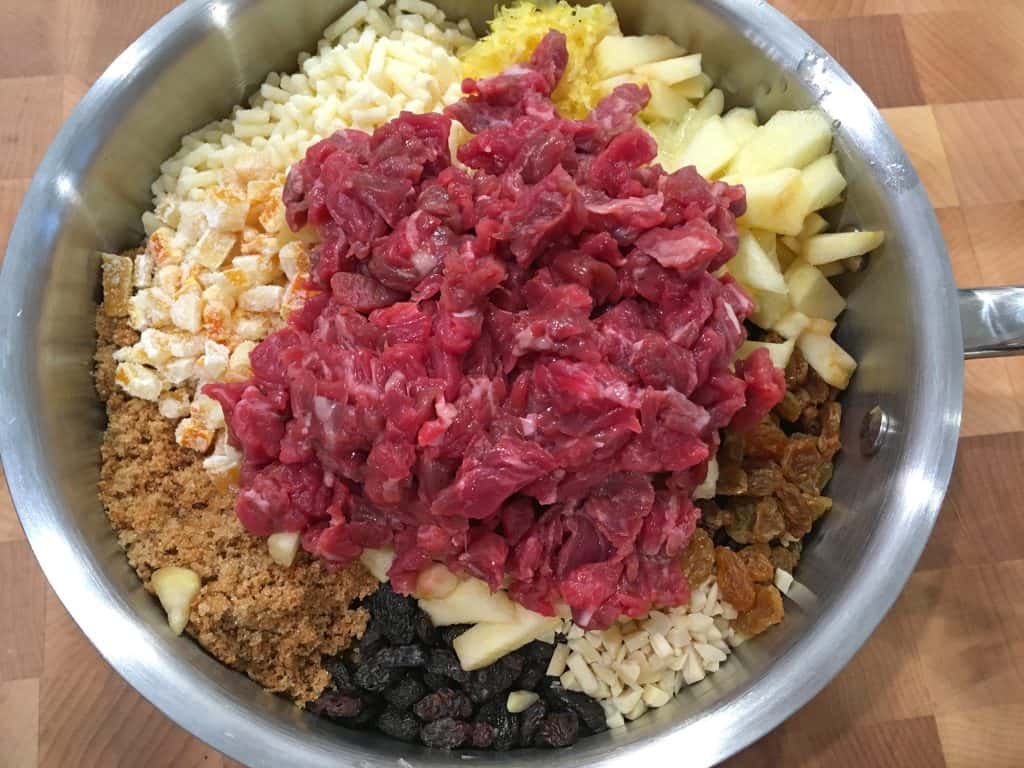
Bring it to a boil and then reduce the heat to LOW and simmer uncovered for about 2 hours, stirring occasionally, more towards the end to prevent burning. If the liquid reduces too soon and the mincemeat starts to stick/scorch on the bottom, add a little bit of apple juice or water.
At the end, stir in the brandy and/or rum. If you prefer to have the alcohol cooked out, add it at the same time as the other ingredients (note, the flavor of the brandy/rum will be less pronounced).
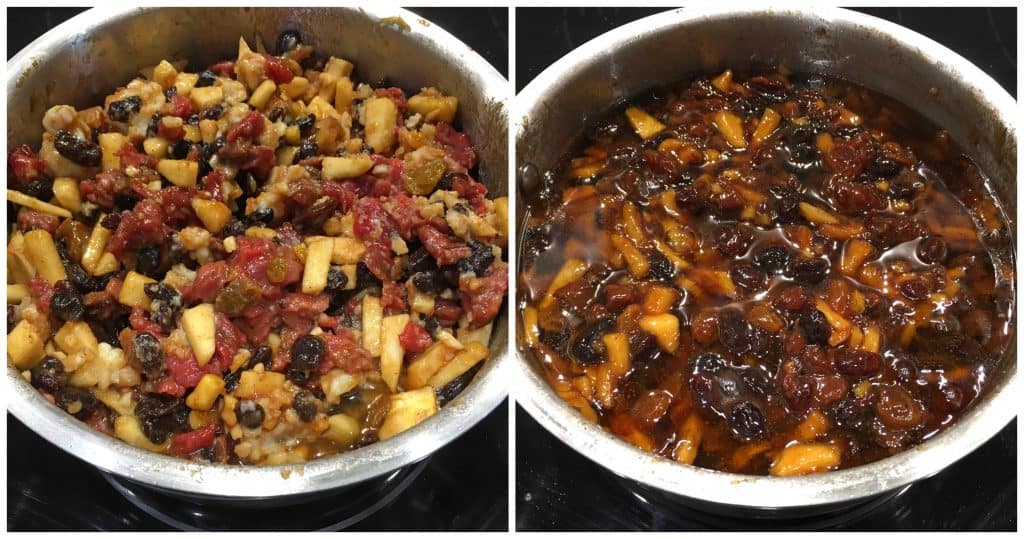
Pour the hot mincemeat into sterilized jars. Let the jars cools.

The liquid suet on top will gradually harden into a protective layer which will enable you to safely store your mincemeat.
**For instructions on different methods for storing your mincemeat, including how to can it for long-term storage, see the blog post section above on Preserving.
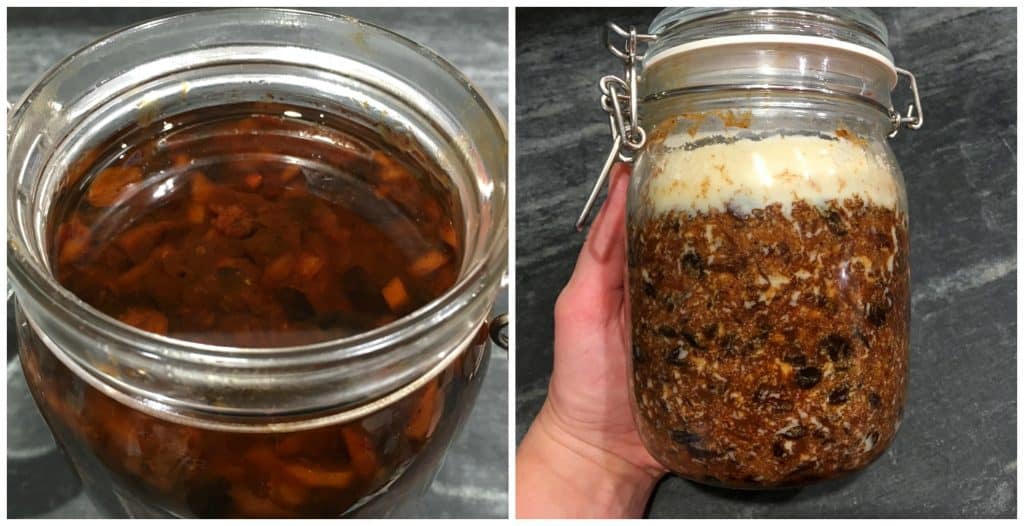
This mincemeat is delicious used immediately but for optimal flavor let it sit in the refrigerator for 1-2 weeks before using. If you’re including the beef in your mincemeat and plan on storing it for longer than a couple of weeks, follow the instructions above for pressure canning your mincemeat.
Now you’re ready to use this mincemeat to make homemade Mince Pies! Or create your own twists by using it for things like mincemeat cake or mincemeat muffins
Enjoy!
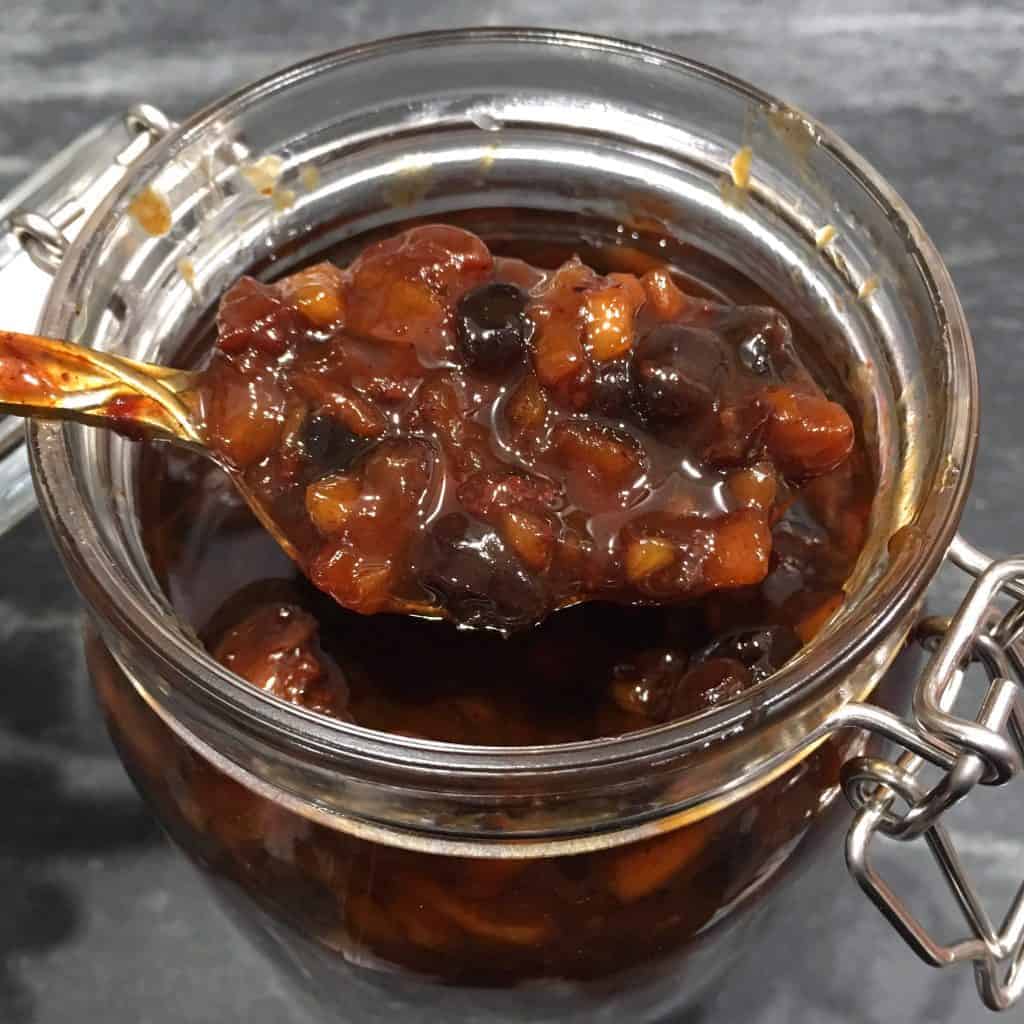
For more delicious traditional British treats, be sure to try our:
- Sticky Toffee Pudding
- Lardy Cake
- Eccles Cakes
- Spotted Dick
- Bara Brith
- Barmbrack
- Mince Pies
- Scottish Shortbread
- Yorkshire Parkin
- Flapjacks
- Victoria Sponge Cake
- Crumpets
- Millionaire’s Shortbread
- Yorkshire Pudding
- Figgy Pudding
Save This Recipe
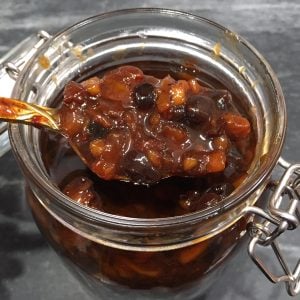
BEST Traditional Mincemeat
Ingredients
- 1 pound (450 grams) finely chopped beef steak , (optional but HIGHLY recommended, otherwise use an extra 1 1/2 cups raisins or currants) **Use a well-marbled cut so it will be tender after the long cooking time; if the cut is lean it will become over-cooked and tough
- Note: Traditionally made with beef or lamb and can also be made with wild game
- 1 1/4 cups (190 grams) raisins
- 1 1/4 cups (190 grams) currants
- 1/2 cup (80 grams) golden raisins
- 2 cups finely chopped tart apple
- 7 ounces (200 grams) shredded beef suet (you can also ask your local butcher for fresh beef suet ground through a fine meat grinder)
- 2 cups (450 grams) packed dark brown sugar
- 2 tablespoons candied lemon peel
- 2 tablespoons candied orange peel
- STRONGLY recommend using Homemade Candied Citrus Peel (click link for recipe)
- 1 1/2 tablespoons (25 grams) finely chopped blanched almonds
- 1 lemon, its zest and juice
- 2 tablespoons apple cider vinegar
- 1 1/2 teaspoons ground cinnamon
- 1/2 teaspoon ground nutmeg
- 1/4 teaspoon ground cloves
- 1/4 teaspoon ground allspice
- 1/4 teaspoon ground mace
- 1/4 teaspoon ground ginger
- 1/4 teaspoon ground coriander
- 2 tablespoons brandy
- 2 tablespoons dark rum
Instructions
- Combine all ingredients except for the brandy and rum in a medium-sized pot and slowly bring to a simmer to prevent scorching. Reduce the heat to LOW and simmer uncovered for about 2 hours, stirring occasionally, more towards the end to prevent burning. (If the liquid reduces too soon and the mincemeat starts to stick/scorch on the bottom, add a little bit of apple juice or water.) Stir in the brandy and rum. (Note: If you prefer to have the alcohol cooked out, add them at the same time as the other ingredients.)
- Spoon the hot mincemeat into sterilized jars (spooning it in the jar while hot will ensure the suet rises to the top to create a layer of fat). As the mixture cools the suet will harden, creating a seal to help preserve the mincemeat. *If you're including the beef be sure to refrigerate the mincemeat. If you're storing it for more than a couple of weeks follow the directions in the blog post for pressure canning the mincemeat for longer-term storage.See blog post for additional ways of storing your mincemeat.
- Makes about 1 quart. Feel free to double, triple, etc, as needed.
- Use this mincemeat to make Homemade Mince Pies! (click link for recipe)
- Note: Mincemeat is traditionally stored for several months before using to allow time for the flavors to deepen, however this mincemeat is also delicious eaten within just a few days.
Notes
Nutrition
Originally published on The Daring Gourmet December 16, 2017



















I have not used your recipe but have one from my mother. We use suet and we use venison for the meat. I will now try it with beef. We also use lard for the crust. We do not add the alcohol but will now try it. Our recipe is from my grandmother born in the 1800’s.
Hello
How can you simmer this recipe….there are no liquids….I am a bit confused here
Hi Patrick, once the lard and sugar dissolves along with the juice from the apples, there will be a good amount of liquid.
Jury’s still out on the actual pies, but…
This should make a LOT more than one quart. I doubled it and wound up with about 3 2/3’s quarts.
…which is okay. Assuming the pies turn out well, though, next time around I’ll probably think about upping all the quantities a bit so as to get four full quarts.
Hi Colin, I’m not sure how that’s possible – 3 2/3 quarts is around 14 cups of finished mincemeat which is VASTLY more than the raw ingredients to begin with (and those reduce considerably in volume after cooking). In any case I hope you enjoy the mincemeat!
Love finding a recipe for mincemeat made the way mum use to make it. I’m 75 years old and find that the modern recipes don’t taste anything like food did when I was a child. to the detriment of the taste of food now a days. In our neighborhood lots of people went deer hunting in the fall and they all saved the meat from the neck of the deer for mum to make into mincemeat. venison makes the best mincemeat you’ve ever tasted. She also always used suet in her’s. Everyone would chip in on the cost of the spices and fruit (or the guys who had orchards would bring in the apples) and she would spend days making all the ingredients into the best mincemeat you ever tasted. The batches would be divided equally between all the people who brought in the ingredients and my mum. Thanks for bringing back a recipe that gives me a taste of my childhood and Christmas when I was young.
Thank you so much for sharing those memories, Neala, I really enjoyed reading this and imagining all the work and all the love that went into your mum’s special venison mincemeat. What a beautiful joint effort among neighbors, friends and loved ones. Thank you again for sharing. Warm regards, Kimberly
hi, making the traditional mincemeat, without the beef steak, and want to can in pint jars.
how long should I process. because of the suet i am thinking 45 minutes at 11 lbs pressure.
Hi Michele, I only have the official guidelines for quart-sized jars which is 90 minutes at 11 lbs (up to 2000 ft); I’m not sure what the guidelines say for pints.
I’m puzzled that there isn’t more liquid in the ingredients, A couple of Tablespoons of vinegar and juice of one lemon don’t seem like much to bring to a boil.
Hi Meg, the beef suet, 2 cups of sugar, and apple all melt to produce a considerable amount of liquid.
Just had mince meat pie for the first time!
Damn Yankees(I’m American)
Thanks for the recipe and history of the dish!
Can’t wait to make the candied citrus peels!
That simple syrup will be reserved for Old Fashion Cocktails!! Great information and your knowledge is brilliant.!
Thanks Henry
Fantastic, thank you so much, Henry! Happy New Year!